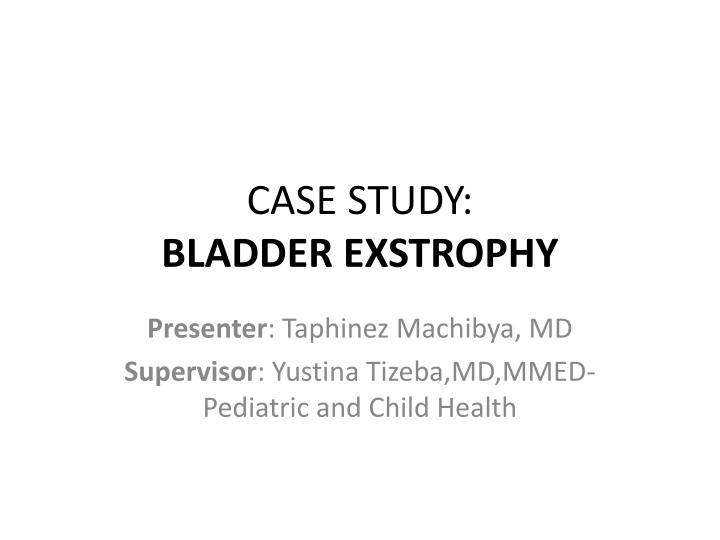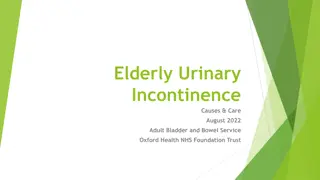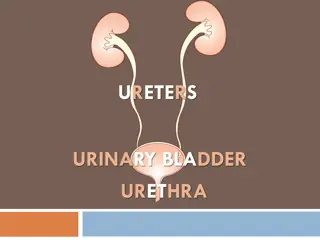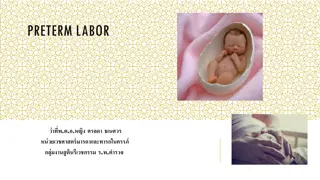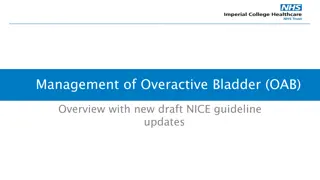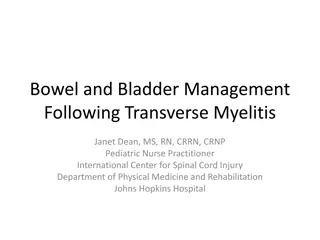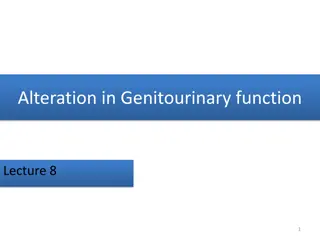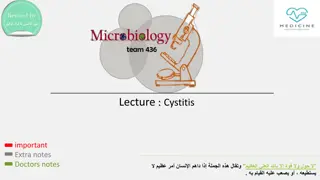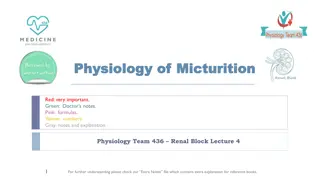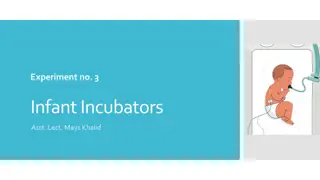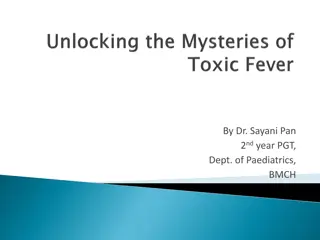Case Study: Bladder Exstrophy in Infant - Presentation and History
Bladder exstrophy case study of a 12-day-old female infant with abnormal swelling and opening in the lower abdomen since birth. The patient's history includes antenatal, natal, and postnatal details without complications. Family-social background information is provided.
Download Presentation

Please find below an Image/Link to download the presentation.
The content on the website is provided AS IS for your information and personal use only. It may not be sold, licensed, or shared on other websites without obtaining consent from the author.If you encounter any issues during the download, it is possible that the publisher has removed the file from their server.
You are allowed to download the files provided on this website for personal or commercial use, subject to the condition that they are used lawfully. All files are the property of their respective owners.
The content on the website is provided AS IS for your information and personal use only. It may not be sold, licensed, or shared on other websites without obtaining consent from the author.
E N D
Presentation Transcript
CASE STUDY: BLADDER EXSTROPHY Presenter: Taphinez Machibya, MD Supervisor: Yustina Tizeba,MD,MMED- Pediatric and Child Health
Case Presentation PATIENT S Identity: Name: PENDO DANIEL Age: 12 DAYS Sex: FEMALE Place of Birth: HOME Address: KABATINI Department: PEDIATRIC AND CHILD HEALTH Patient s File no: 00-17-36 Date of Admission: 12 FEBRUARY, 2020 Time of Admission: 10.30 am, from Home
Main Complain Abnormal swelling and opening in the lower abdomen since birth
HISTORY OF PRESENTING ILLNESS The abnormality in the abdominal wall was seen by the mother after delivery It extends from the lower margins of umbilicus towards the genitalia The baby was able to suck, breath well, cry normal, and pass stool normally However there was spontaneous leakage of fluid from the swelling that caused wetting on the dressings throughout. No obvious bleeding was seen No history of convulsion, DIB,Loss of consciousness, abnormal bleeding or difficult in breastfeeding.
Pre natal History Mother is 21 yrs old, this was the 3rdpregnancy (P3L3) Ante - Natal Clinic ; 3 visitations in the last three months of pregnancy (October, November, December), received Folate tabs and SP. No Vaccination given Hx of use of Dawa Tatu No any hx of pregnancy complication (PPROM or PV bleeding) No hx of smoking,maternal Tobacco use,
Natal History Normal labour duration Delivered by SVD at home Born at term , 9 months Cried immediately after birth Sucked within 1 hr post delivery No yellowish or bluish discoloration On inspection the mother noted abnormal swelling below the umbilicus that is coming from inside the abdomen with watery leakage, pinkish in color with no abnormal smell or bleeding. Body weight currently: 2.8Kgs
Post Natal History Cord dropped at 2ndday of life No neonatal yellowish or bluish discoloration Able to breast feed up to date Normal defecation Abnormal urine passage through the lesion No any vaccination received
FAMILY - SOCIAL HISTORY Index is the 3rdborn in the family to her parents 2ndborn is male, 2 yrs doing fine 1stborn is male , 4yrs, doing fine. The mother is the 1stwife 2ndwife has two children (2yrs F, and 6/12 old , M both doing fine) No any history of same condition in the family or any other chronic diseases history. Both parents are peasants House is iron roofed with wire meshed window No Health insurance for family members Food availability is 2-3 meals per day, almost the same food of stiff porridge with fish , meat or vegetables and the father is the main provider of the family
On Examination Generally: Alert, active, pink skinned Not pale, no jaundice, no DIB, No LL edema Normal muscle bulkiness, tone, and power- 5/5 both ULs and LLs Normal upper and lower limbs anatomically Both reflexes normal per age (suckling, gag, moro , symmetrical tonic neck, rooting, grasping)
Per ABDOMEN Normal contour Moves with respiration Umbilicus normal size and shape An opening lesion with protruding mass from inside the abdomen , suprapubic area, measuring of 9x6x4cm3, pinkish , non foul smelling, and watery fluid leakage throughout No obvious bleeding seen Margins of the lesion: upper roof at 1cm from umbilicus, extension to the Labia majora bilaterally, and distends to the superior aspect of the clitoris No other mass or organomegally palpable Perforate anus with normotone sphincter
Cardiovascular system HR 142 bpm Apex beat at 4thintercostal space No pre-cordial hyperactivity Heart sounds 1 and 2 heard with no murmurs No raised JVP Pulse character: strong, regular regular rhythm
Respiratory system RR- 36 breathes per minute Chest moves symmetrically No any chest skin lesion noted Trachea centrally located Resonant note on percussion Normal bronchial breathe sounds bilaterally No anterior lower chest wall indrawing
Central Nervous System Alert, fully conscious Normal scalp with normal fontaneles Open eyes spontaneous Positive suckling reflexes Gag reflexes positive Grasping reflexes normal Occipital Frontal Circumference 34cm Can feel on touch
ENT Normal ears Normal throat Normal nose Can sense some sounds No cleft lesions per oral or Throat lesions seen
Provisional diagnosis BLADDER EXSTROPHY Ddx: Cloacal Exstrophy Cloacal malformation
Management Plan IV ceftriaxone 500mg bid 5/7 IV Metronidazole 250mg 8hrly 5/7 Wound dressing with sterile gauze and exchange 4hrly Continue breast feeding and Nursing care Abdominal USS (R/O other urogenital anomalies) ECHO For Pediatrician review Urology / Pediatric surgery review and management (Referral system)
Vaccination plan; To be given BCG, OPV0* (*before 14 days) And counselled the parents on other vaccination plan follow up (EPI) completely
Abdominal USS Results Bilateral hydronephrosis Other organs normal
ECHO results Normal heart shape Normal cardiac activities Normal valves and vessels Conclusion: Normal Echo-Cardiological findings
Conclusion Wdx: Bladder Exstrophy with Bilateral Hydronephrosis MEDICAL PLAN: Referral to Bugando Medical Centre for Surgical management of the patient.
Counselling session Wellbeing Prognosis of the child post surgical management and psychological assurance (Good if done within 18 months) Counselling to the parents about genetical screening to avoid further recurrence of the same condition and other restrictions like Tobacco use for the future pregnancies Joining iCHF or NHIF insurance for future medical management and agreed
Medical aspect and Short preview Bladder exstrophy is a complex, rare disorder that occurs early on while a fetus is developing in the womb. As the bladder is developing, the abdominal wall does not fully form, leaving the pubic bones separated and the bladder exposed to the outside skin surface through an opening in the lower abdominal wall. Because the bladder and urethra are not closed, the bladder cannot store urine. Urine produced by the kidneys drains into this open area.
EPIDEMIOLOGY Bladder exstrophy occurs in approximately 1 in every 50,000 live births and is slightly more common in males. The disorder may occur in varying degrees and may involve other organs including the bowel, external genitalia and pelvic bones. To USA Prevalence goes up to 3.3/100,000 births. For Classic bladder exstrophy, the Male to female ratio is 2.3:1 and as high as 6:1 in some studies. These conditions seem to be more common in Whites than in other races.
Bladder exstrophy diagnosis and evaluation Exstrophy of the bladder can usually be diagnosed by fetal ultrasound before an infant is born. Bladder exstrophy is suspected when ultrasound shows that the baby s bladder is not filling and emptying normally. Fetal imaging experts will look for several other indicators to confirm the diagnosis, including a low umbilical cord with an abdominal bulge below the cord insertion (representing the opened bladder halves, or bladder plate) and unclear male or female genitalia. Bladder exstrophy is not usually associated with other ultrasound findings (But not strictly) or chromosomal or genetic syndromes. However, for gender identification, an amniocentesis may be recommended. If bladder exstrophy is not prenatally diagnosed, the bladder defect is easily visible after birth.
Prenatal care and delivery of babies with bladder exstrophy A prenatal diagnosis of bladder exstrophy does not typically change prenatal care, routine delivery planning, timing or mode of delivery.
PARENTAL COUNSELLING AND PSYCHOLOGICAL SUPPORT Bladder exstrophy can be an overwhelming diagnosis for parents, but our aim as medical team should aim to support the parent from before birth through delivery and beyond.
TREATMENT Treatment for bladder exstrophy includes surgical repair. The goal of treatment is to optimize urinary control, to preserve normal renal function, and to optimize the appearance and function of the external genitalia. If left untreated, normal urine continence does not occur and normal sexual function is compromised.
Images showing both a female (left) and male (right) baby with an exposed bladder caused by bladder exstrophy.
Take Home message Early ANC visitation; as soon as the mother misses her period and discover she is pregnant Atleast once USS scanning in each pregnancy Early and timely referral system
References Pediatric Medical Records Unit, Katavi Regional Referral Hospital Tanzania STANDARD TREATMENT GUIDELINES AND ESSENTIAL MEDICINES LIST FOR CHILDREN AND ADOLESCENTS, First Edition October 2017 WHO Pediatric Pocket Book, 2013 (2ndEdition) Mediscape, Exstrophy and Epispadias; Elizabeth B Yerkes, MD (Feb 2,2019) An Illustrated Guide To Pediatric Surgery by Ahmed H. Al-Salem, 2014 Atlas of Pediatric Surgical Techniques,Elsever. 1ST Edition,2010 by Dai Chung and Mike Chen
